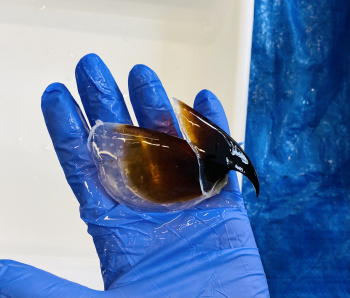
Posted by SASTA
on 17/03/2025

Zoë Doubleday – Senior Research Fellow and Lecturer, University of South Australia
As an environmental scientist, I’m an avid recycler at home. But I also apply the “reduce, reuse, and recycle” ethos to the workplace as well, and I’m not just talking about recycling the refuse of my lunch, I’m talking about recycling scientific samples. There is a treasure trove of environmental data, ready and waiting, inside the hardened body parts of plants and animals. These body parts, like skeletons, teeth and shells, can be extracted from individuals that have already been harvested for food, materials, or science, that have died of natural causes or indirectly from human activities. These body parts are held in research agencies, museums, and even people’s offices, collecting dust over the decades. It was this untapped data resource and my love of recycling that drew me into the world of chemical sclerochronology.
Chemical sclerochronology is the study of chemical variations in the hardened body parts of organisms. These body parts grow layer upon layer, through time, incorporating various chemicals from the environment. These chemical datasets are permanently preserved within the layers and provide a window into the past. Scientists like myself extract these datasets, seek to understand what they represent, and then use them to reconstruct the lives of animals and plants and their surrounding environment. In other words, the biodiversity around us is like a natural data logger, continuously recording and preserving data about our changing world.
Sclerchronology has had a traditional focus on marine and freshwater organisms and is the sister science to dendrochronology – the study of tree rings. However, sclerochronology covers a much broader range of plants and animals that represent a much broader range of environments and lifestyles – think of a snail living in an alpine lake, a soft coral living in deep polar seas, or even a whale that migrates vast distances across the open oceans. Also, sclerochronology deals with organisms that both move and don’t move, so we’re not just interested in reconstructing the environment per se but also how an organism moves through it (i.e. where it eats, where it breeds, and where it grows up) and how its biology may change through time (such as diet, metabolism, and growth).
So, what are these chemical variations? Researchers typically look at variations in stable isotope ratios, like carbon, nitrogen, and oxygen, as well as trace element concentrations, like strontium and barium, along the growth axis of the body part in question. These chemical “markers” can provide insights into, say, how warm or salty the water is through time or the critical nursery grounds or migration routes of an endangered species. And with advances in technology, new, powerful chemical markers are being developed, which are opening fresh avenues to recycle samples and extract critical data. One example of these new markers is reproductive hormones, which can be extracted from hardened body parts, like whale baleen, and used to reconstruct the reproductive histories of the animal. My PhD student, Erica Durante, recently developed a method to extract reproductive hormones (estrogen and progesterone) from cephalopod beaks (a hardened body part that resembles a bird beak) (https://aslopubs.onlinelibrary.wiley.com/doi/10.1002/lol2.70000). I know it is weird thinking that invertebrates have these hormones, but they do and by analysing these hormones in the beaks, we can collect critical data on how cephalopods reproduce. For example, there are so many cephalopod species we know little about because they are hard to find or catch (think giant squids, deep sea squids, Antarctic octopus). Fortunately, beaks don't readily break down and can be found everywhere – in museums and in the stomachs of marine mammals and seabirds, for instance – and they also lay down daily growth rings, allowing us to go back in time and collect lifetime data on an animal’s biology. Take the picture below. Here, I'm holding the beak of a giant octopus squid or Taningia danae (really a squid with 8-arms), found in a half rotten carcass likely spewed up by a whale. This impressive creature grows up to 150 kg, but we know next to nothing about it. By using Erica’s method and extracting reproductive data from the beaks retrospectively, we can change that!!

Here I’m holding the beak of a giant octopus squid or Taningia danae. By applying the science of sclerochronology to this beak (found in a deceased animal floating in the ocean), we can gain a lot of information about this poorly understood species. Image credit: Zoe Doubleday
Researchers have largely stuck to three animal groups when it comes to extracting chemical data: fish, bivalve molluscs (like clams and scallops), and hard corals (these are the famous ones that form iconic coral reefs). However, our recent study showcases a whole world of weird and wonderful organisms that can expand our data collection needs (https://aslopubs.onlinelibrary.wiley.com/doi/10.1002/lol2.10448). We found that useful chemical data could be extracted from organisms spanning nine different phyla, ranging from mammals and algae to arthropods, sponges, and soft corals, with some surprisingly useful applications. For example, under-appreciated organisms such as soft corals, gastropods, barnacle sponges, coralline red algae, and brachiopods (a weird group of animals that look a little like a clam, but they are completely different) have all been used to understand environmental change. Soft corals are also masters when it comes to monitoring environmental pollution because, unlike their hard coral cousins, they are protein-based with a high nitrogen content. As such, they are excellent recorders of nutrient pollution caused by human activities and have even been used to monitor the impacts of tourism. All sorts of organisms and body parts can also be used to monitor heavy metals and well as rare earth metals in the environment including squid beaks, walrus teeth, and penguin feathers.

The wide range of aquatic organisms across the tree of life that can be used to collect environmental and ecological data using chemical sclerochronology. Figure adapted from Doubleday et al. 2025. Capitalizing on the wealth of chemical data in the accretionary structures of aquatic taxa: Opportunities from across the tree of life. Limnology and Oceanography Letters. doi.org/10.1002/lol2.10448.
But the true beauty of sclerochronology is that it really allows you to take the “reduce, reuse, and recycle” ethos into the lab. For example, if an organism is endangered or rare, the last thing researchers want to do is collect data on that organism using fatal methods. But by using body parts that already exist (i.e. from accidental deaths or historical archives), critical data can be obtained on endangered species to inform their effective management and conservation (think scutes from turtles, baleen from whales, teeth from dolphins, vertebrae and eye lenses from sharks, feathers from seabirds, and whiskers and hair from sea lions, otters, and even polar bears!).
And as a last note, in science, we need to be resourceful because there are not many resources to go around. Opportunistic data collection via chemical sclerochronology can provide a cheap, ready source of data on environments and organisms living in watery environments that are largely inaccessible to humans. Tapping into this wealth of data will help us to track environmental change, species ecology, and human impacts, informing conservation strategies so we can manage our ecosystems more effectively.
In this Section
Archive
- July 2025
- June 2025
- May 2025
- April 2025
- March 2025
- February 2025
- January 2025
- December 2024
- November 2024
- October 2024
- September 2024
- August 2024
- July 2024
- June 2024
- May 2024
- April 2024
- March 2024
- February 2024
- December 2023
- November 2023
- October 2023
- September 2023
- July 2023
- June 2023
- May 2023
- April 2023
- March 2023
- February 2023
- January 2023
- December 2022
- November 2022
- October 2022
- August 2022
- July 2022
- June 2022
- May 2022
- April 2022
- March 2022
- February 2022
- January 2022
- December 2021
- November 2021
- October 2021
- September 2021
- August 2021
- July 2021
- June 2021
- May 2021
- April 2021
- March 2021
- February 2021
- January 2021
- December 2020
- November 2020
- October 2020
- September 2020
- August 2020
- July 2020
- June 2020
- May 2020
- April 2020
- October 2018
- September 2018
- August 2018
- July 2018
